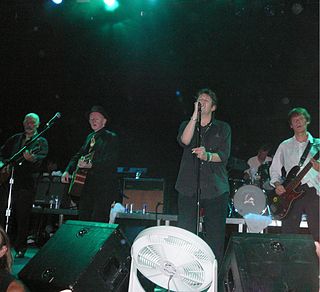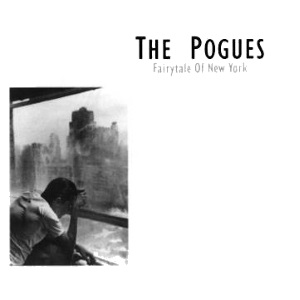Computer music is the application of computing technology in music composition, to help human composers create new music or to have computers independently create music, such as with algorithmic composition programs. It includes the theory and application of new and existing computer software technologies and basic aspects of music, such as sound synthesis, digital signal processing, sound design, sonic diffusion, acoustics, electrical engineering, and psychoacoustics. The field of computer music can trace its roots back to the origins of electronic music, and the first experiments and innovations with electronic instruments at the turn of the 20th century.

The Pogues were an English or Anglo-Irish Celtic punk band fronted by Shane MacGowan and others, founded in King's Cross, London, in 1982, as Pogue Mahone—an anglicisation by James Joyce of the Irish phrase póg mo thóin, meaning "kiss my arse". Fusing punk influences with instruments such as the tin whistle, banjo, Irish bouzouki, cittern, mandolin and accordion, the Pogues were initially poorly received in traditional Irish music circles—the noted musician Tommy Makem called them "the greatest disaster ever to hit Irish music"—but were subsequently credited with reinvigorating the genre. The band later incorporated influences from other musical traditions, including jazz, flamenco, and Middle Eastern music.

4′33″ is a modernist composition by American experimental composer John Cage. It was composed in 1952 for any instrument or combination of instruments; the score instructs performers not to play their instruments throughout the three movements. It is divided into three movements, lasting 30 seconds, two minutes and 23 seconds, and one minute and 40 seconds, respectively, although Cage later stated that the movements' durations can be determined by the musician. As indicated by the title, the composition lasts four minutes and 33 seconds and is marked by a period of silence, although ambient sounds contribute to the performance.

Max Vernon Mathews was an American pioneer of computer music.
Algorithmic composition is the technique of using algorithms to create music.
Background music is a mode of musical performance in which the music is not intended to be a primary focus of potential listeners, but its content, character, and volume level are deliberately chosen to affect behavioral and emotional responses in humans such as concentration, relaxation, distraction, and excitement. Listeners are uniquely subject to background music with no control over its volume and content. The range of responses created are of great variety, and even opposite, depending on numerous factors such as, setting, culture, audience, and even time of day.
Jeremy Max Finer is an English musician, artist and composer. He was one of the founding members of The Pogues.

If I Should Fall from Grace with God is the third studio album by Celtic folk-punk band the Pogues, released on 18 January 1988. Released in the wake of their biggest hit single, "Fairytale of New York", If I Should Fall from Grace with God also became the band's best-selling album, peaking at number three on the UK Albums Chart and reaching the top ten in several other countries.

Trinity Buoy Wharf is the site of a lighthouse, by the confluence of the River Thames and Bow Creek on the Leamouth Peninsula, Poplar. It lies within the London Borough of Tower Hamlets. The lighthouse no longer functions, but is the home of various art projects such as Longplayer. It is sometimes known as Bow Creek Lighthouse.

"Fairytale of New York" is a song written by Jem Finer and Shane MacGowan and recorded by their London-based band the Pogues, featuring English singer-songwriter Kirsty MacColl on vocals. The song is an Irish folk-style ballad and was written as a duet, with the Pogues' singer MacGowan taking the role of the male character and MacColl playing the female character. It was originally released as a single on 23 November 1987 and later featured on the Pogues' 1988 album If I Should Fall from Grace with God.

Hell's Ditch is the fifth studio album by The Pogues, released on 1 October 1990, and the last to feature frontman Shane MacGowan as a member.

A standing bell or resting bell is an inverted bell, supported from below with the rim uppermost. Such bells are normally bowl-shaped, and exist in a wide range of sizes, from a few centimetres to a metre in diameter. They are often played by striking, but some—known as singing bowls—may also be played by rotating a suede covered mallet around the outside rim to produce a sustained musical note.

In music, transcription is the practice of notating a piece or a sound which was previously unnotated and/or unpopular as a written music, for example, a jazz improvisation or a video game soundtrack. When a musician is tasked with creating sheet music from a recording and they write down the notes that make up the piece in music notation, it is said that they created a musical transcription of that recording. Transcription may also mean rewriting a piece of music, either solo or ensemble, for another instrument or other instruments than which it was originally intended. The Beethoven Symphonies transcribed for solo piano by Franz Liszt are an example. Transcription in this sense is sometimes called arrangement, although strictly speaking transcriptions are faithful adaptations, whereas arrangements change significant aspects of the original piece.

Dan Wool is an American composer and sound designer. Originally from St. Louis, Missouri, where he played in the punk rock band The Strikers, he is based in San Francisco, California. He has worked in New York, Los Angeles, London, Mexico City, and Anhui (China), creating scores for broadcast television projects, theatrical sound installations and more than 45 feature films, including nine films for celebrated cult filmmaker Alex Cox. From 2010 to 2021 Wool collaborated with filmmaker, and legendary special effects artist Phil Tippett to create the score for Tippett's epic stop-motion feature film Mad God. Wool has also composed music for television movies and episodic series for ABC, CBS, FOX, NBC, and HBO. He is often recognized for his work as principal composer in film score soundtrack-group Pray for Rain.
The largest creative work is the largest or longest item in different fields of creative works. Some pieces were created with the specific intention of holding the record while others have been recognised for their size after completion.
Matthew Burtner is a contemporary American composer. His most recent work at the University of Virginia includes MICE, the mobile interactive computer ensemble.
John Eacott is a British jazz trumpeter and composer.
HPSCHD is a composition for harpsichord and computer-generated sounds by American avant-garde composers John Cage (1912–1992) and Lejaren Hiller (1924–1994). It was written between 1967 and 1969 and was premiered on May 16, 1969, at the Experimental Music Studios at the University of Illinois at Urbana–Champaign.
Artangel is a London-based arts organisation founded in 1985 by Roger Took. Directed since 1991 by James Lingwood and Michael Morris, it has commissioned and produced a string of notable site-specific works, plus several projects for TV, film, radio and the web. Notable past works include the Turner Prize-winning House by Rachel Whiteread (1993), Break Down by Michael Landy (2001) and Seizure by Roger Hiorns (2008–2010), also nominated for the Turner Prize in 2009.

AS Long As Possible (ASLAP) (2015–2017) is a 1,000-year long animated GIF made by Finnish artist Juha van Ingen. It premiered at Kiasma National Museum of Contemporary Art in Helsinki on 28 March 2017. The animation is created in collaboration with developer and sound artist Janne Särkelä.














